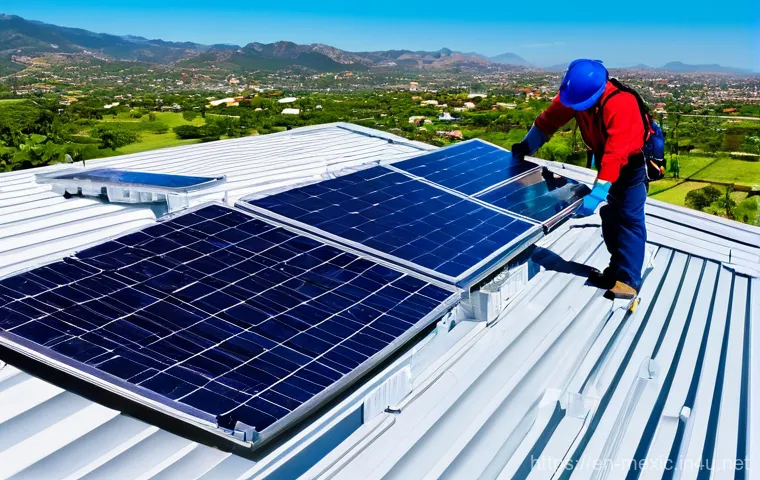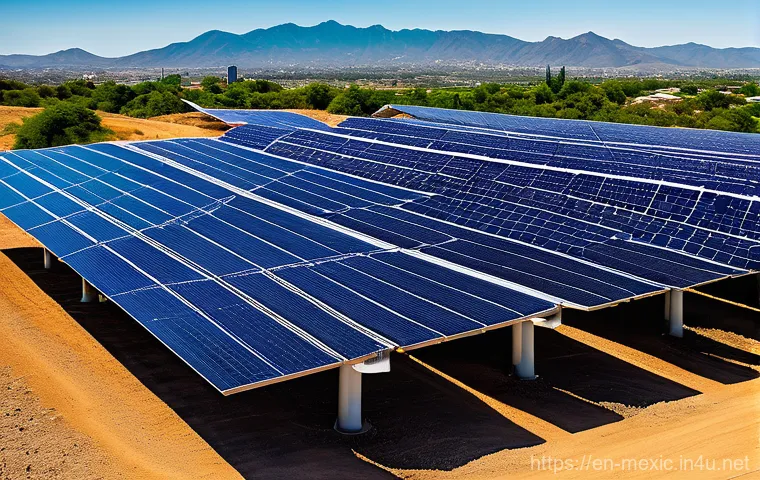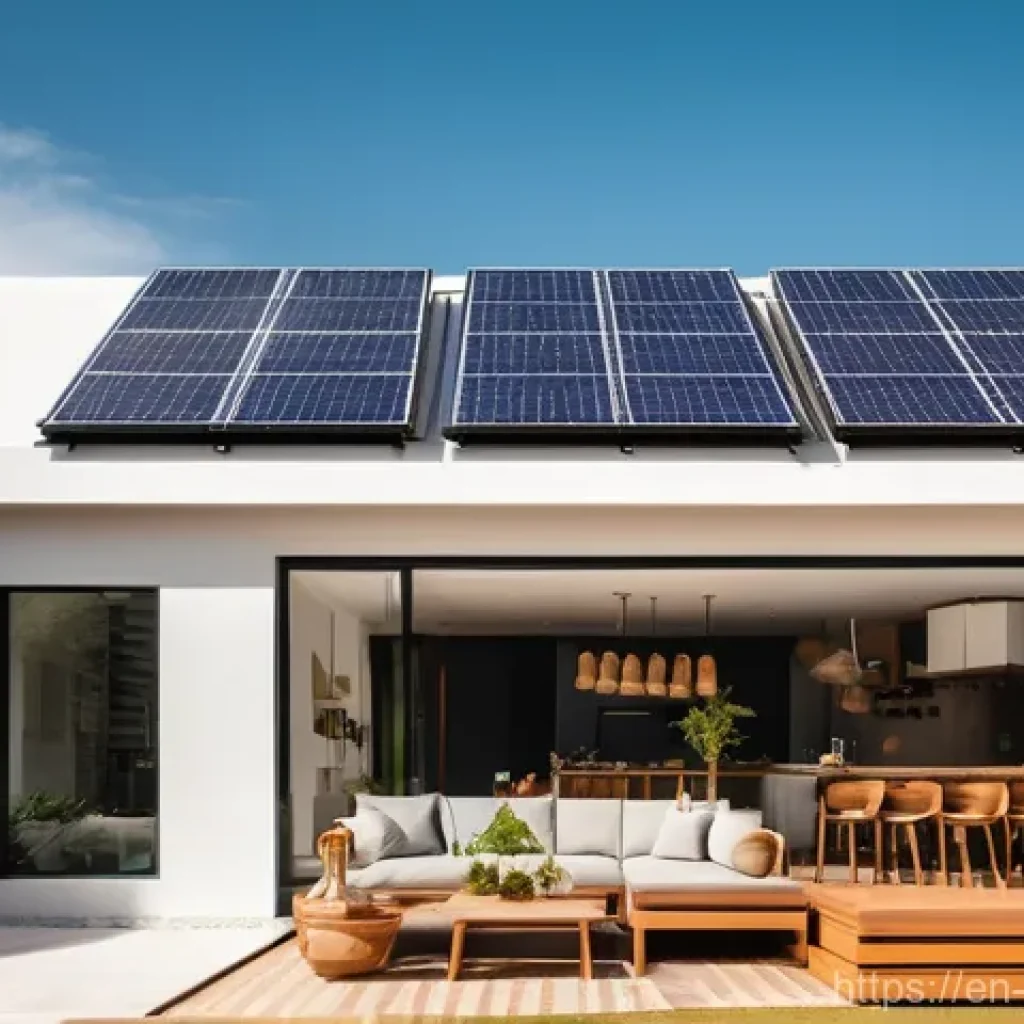Hey there, sun-seekers and smart savers! Have you ever looked up at the brilliant Mexican sun and thought, “Wow, that’s a lot of free energy just waiting to be tapped?” I certainly have!
Living here, you quickly realize our abundant sunshine isn’t just for beautiful beach days; it’s a goldmine for your home and wallet. We’re talking about more than just going green – we’re talking about slashing those ever-increasing CFE bills, boosting your property’s value, and even gaining a little energy independence that feels incredibly empowering.
With electricity costs consistently on the rise and a growing awareness about our environmental footprint, harnessing solar power in Mexico isn’t just a trend; it’s quickly becoming a smart, savvy lifestyle choice for homeowners and businesses alike.
I’ve personally seen friends and neighbors transform their monthly expenses, and honestly, the thought of turning that glorious sunshine into tangible savings is just too good to pass up.
Mexico is truly a global leader in solar potential, receiving some of the highest solar radiation worldwide, and with recent government pushes for renewable energy and favorable policies like net metering, it’s never been a better time to consider making the switch.
It’s not as complicated or costly as you might think, especially with installation costs declining and payback periods often surprisingly short. Ready to discover how you can turn Mexico’s incredible solar resources into significant savings and a greener lifestyle?
Let’s dive deeper and uncover exactly how you can make solar work for you right here, right now!
The Real Buzz About Your CFE Bill: Unlocking Epic Savings

Okay, let’s get down to the nitty-gritty, because for most of us, the biggest motivator to go solar here in Mexico is undeniably our CFE bill. And let me tell you, it’s a game-changer! I’ve personally witnessed friends and neighbors go from dreading that bimonthly envelope to barely noticing it. Imagine slashing your electricity costs by 90% or even more – it’s not a dream, it’s a very real possibility with solar in Mexico. The rising cost of electricity is a global headache, but here, with CFE’s notorious high-tier DAC (Doméstica de Alto Consumo) tariff, it can be a real punch to the gut. Once your consumption hits a certain threshold, those rates skyrocket, making solar not just a ‘nice to have’ but a ‘must-have’ for savvy homeowners like us. By generating your own power, you’re effectively freezing your electricity price for the lifespan of your system, protecting yourself from those unpredictable increases that seem to hit us year after year. Think about it: an average increase of 6% annually over the last 16 years, with estimates for even higher growth in the coming years, makes that solar investment look sweeter and sweeter with each passing day. For many, the return on investment (ROI) is surprisingly quick, often within 4 to 6 years, especially if you’re on a high-consumption tariff. After that, it’s essentially free electricity for decades to come, translating into massive long-term savings and a truly satisfying sense of energy independence. It’s a feeling of control over your finances that’s hard to beat.
Say Goodbye to DAC Rates and Hello to Net Metering
If you’re living in Mexico, you’re probably all too familiar with the dreaded DAC tariff. It’s CFE’s way of penalizing high energy users, and it can turn a normal electricity bill into a shocking expense. But here’s the magic trick: solar panels virtually eliminate your reliance on CFE during the day, significantly reducing your consumption from the grid and pushing you out of those costly DAC rates. On top of that, Mexico has a fantastic system called “Net Metering” (or “Medición Neta” locally), which is like having a bank account for your excess solar energy. When your panels generate more electricity than your home consumes, that surplus energy is sent back to the CFE grid, and you get credits on your bill. These credits then offset the energy you pull from the grid when your panels aren’t producing, like at night or on cloudy days. In the past, any unused credits after 12 months might have been lost, but recent changes mean CFE will actually pay you for that leftover surplus at the local marginal price. This means your solar system isn’t just saving you money; it could actually be earning you a little extra cash! It’s an incredibly smart way to maximize every ray of sunshine. I’ve heard stories of people whose bimonthly bills went from 2,500 MXN down to a symbolic 50 MXN – that’s almost 100% savings, which is just incredible!
Making Your Money Work: The Solar ROI Sweet Spot
When we talk about investments, we’re usually thinking stocks or real estate, right? But solar in Mexico? That’s a serious contender for a stellar ROI, especially when you consider how quickly you can recoup your initial outlay. I’ve seen figures suggesting payback periods as low as 2 to 5 years for high-consumption users, which is frankly astonishing. Even the more conservative estimates of 4 to 6 years are incredibly attractive, particularly when you factor in the rising cost of traditional electricity. For instance, customers in Baja California on high residential rates are seeing their full investment returned in less than 4 to 5 years, thanks to annual electricity price increases of 6-9%. After that, it’s pure profit for the remaining 20-30+ years of your solar system’s life. Think about the cumulative savings over two or three decades! One Reddit user even shared their experience of paying $126,000 MXN for a 10-panel system and now paying only $31 pesos monthly, generating a 33% annual return on their investment. That’s not just saving; that’s generating wealth right from your rooftop. And let’s not forget the immediate tax benefits for businesses, allowing 100% accelerated depreciation in the first year, which can reduce your tax bill by up to 30%. For homeowners, while there isn’t a nationwide tax credit like in the U.S., you often benefit from zero VAT on residential installations, which is a nice upfront saving. It all adds up to a compelling financial argument.
Decoding Mexico’s Solar
Getting solar installed might seem a bit daunting when you think about permits and regulations, but honestly, it’s far more streamlined than you might imagine, and the Mexican government is actually quite supportive. Since the energy reform in 2013, Mexico has made significant strides in encouraging renewable energy, and solar is a big part of that push. They’ve created a regulatory framework that makes it entirely legal and, frankly, quite beneficial for homeowners and businesses to generate their own power. My experience, and what I hear from others, is that a reputable installer will guide you through every single step, making the process smooth sailing. You’re not expected to navigate the bureaucratic maze alone, which is a huge relief. The key is understanding that while the sun is free, connecting to the national grid – our beloved CFE – requires a bit of paperwork and a few technical checks to ensure everything is safe and compliant. But trust me, the long-term benefits of being interconnected are absolutely worth it. It’s about more than just personal savings; it’s about being part of a larger, greener energy infrastructure that benefits everyone.
Navigating the Paperwork: CFE and Interconnection
The first big step after deciding to go solar is typically the interconnection process with CFE. This is where your solar system gets officially linked to the national electricity grid, allowing you to participate in net metering. Don’t let the thought of paperwork overwhelm you; professional solar installers in Mexico are experts at this. They usually handle the entire application, including filling out the interconnection form (often called “Anexo 2”), providing all the technical specifications of your panels and inverter, and even submitting a diagram of your system. The Energy Regulatory Commission (CRE) and the Secretary of Energy (SENER) play roles in setting policies and overseeing clean energy integration, but your direct interaction will mostly be with CFE for the practical connection. Once your application is approved, CFE will typically replace your old meter with a special bidirectional meter. This smart meter is crucial because it accurately tracks both the electricity you consume from the grid and the excess solar electricity you feed back into it. The whole approval process usually takes about 3-6 weeks, depending on your location and system size. It’s a pretty standard procedure, and having your installer manage it all really takes the stress off your shoulders, ensuring everything is above board and ready to maximize your savings.
Government Support and Incentives: More Than Just Sunshine
While the abundant sunshine is our primary incentive, the Mexican government isn’t just relying on nature to drive solar adoption; they’ve put some helpful policies and incentives in place. Beyond the fantastic net metering scheme, which I’ve already raved about, there are other noteworthy benefits. For businesses, the 100% accelerated depreciation mentioned earlier is a huge win, allowing companies to deduct the full cost of their solar equipment in the first year. This can significantly offset the initial investment. Although a broad federal tax credit for homeowners, similar to the U.S. ITC, isn’t currently a nationwide standard in Mexico, residential solar installations often benefit from a 0% VAT, effectively lowering the upfront cost. Some regions or local municipalities might even offer additional incentives, so it’s always worth checking with your chosen installer about what might be available in your specific area. The larger picture is also important: Mexico has national targets for clean energy, aiming for 33% renewable energy by 2030, and solar plays a vital role in bridging that gap. This strong governmental backing means the future for solar in Mexico looks bright, with continued support and decreasing technology costs making it an increasingly accessible option for everyone.
Choosing Your Sunshine Solution: Panels, Inverters, and Smart Sizing
Alright, so you’re convinced that solar is the way to go – awesome! Now comes the exciting part: choosing the right system for your home. It’s not just about slapping some panels on the roof; it’s about creating a tailor-made solution that fits your unique energy needs and maximizes your savings. I’ve learned that a good installer acts like a detective, analyzing your past electricity consumption (those old CFE bills are actually gold!), assessing your roof’s space and sun exposure, and then designing a system that’s just right. It’s a personalized approach, because what works for a small casita might not cut it for a sprawling hacienda, and vice-versa. Plus, the technology itself has come a long, long way. The efficiency of panels, the smarts of inverters – it’s all evolving rapidly, offering incredible performance and durability. You’ll hear terms like monocrystalline and polycrystalline, string inverters and micro-inverters, and while it might sound like a foreign language at first, a good professional will break it down for you, explaining the pros and cons in plain English so you can make an informed decision without feeling overwhelmed. It’s all part of the journey to becoming energy independent and feeling really good about your home.
Panel Power: Monocrystalline vs. Polycrystalline
When you start looking into solar panels, you’ll primarily encounter two main types for residential use: monocrystalline and polycrystalline. Monocrystalline panels, easily identifiable by their uniform, dark black appearance, are generally considered the premium option. They are made from a single, pure crystal of silicon, which allows them to be more efficient at converting sunlight into electricity, especially in conditions where roof space might be a bit limited. This higher efficiency means you can generate more power with fewer panels, potentially a huge advantage if your roof isn’t massive. Polycrystalline panels, on the other hand, have a blue, speckled appearance and are made from multiple silicon crystal fragments. They’re typically a bit less efficient but also more cost-effective upfront. For homes with ample roof space and a slightly tighter budget, polycrystalline panels can still deliver fantastic savings. The choice often comes down to a balance between initial cost, available space, and desired aesthetic. Personally, I lean towards monocrystalline if the budget allows, just for that extra punch of power and sleek look, but both types are incredibly robust and designed to perform beautifully under the Mexican sun for decades. Your installer will perform a detailed load analysis and assess your roof to recommend the optimal type and number of panels to perfectly offset your CFE consumption.
The Brains of the
Beyond the panels themselves, the inverter is truly the brain of your solar system. This crucial piece of equipment converts the direct current (DC) electricity generated by your panels into alternating current (AC) electricity that your home appliances use and that can be fed back into the CFE grid. There are a few main types, including string inverters, which connect multiple panels in a “string” to a central inverter, and micro-inverters, which are installed on each individual panel. Micro-inverters offer benefits like optimizing each panel’s output independently, which can be great if parts of your roof are shaded at different times of the day, ensuring your system performs optimally even if one panel isn’t pulling its weight. System sizing is another critical factor. This isn’t about the physical size of your house but rather your average electricity consumption in kilowatt-hours (kWh). A good solar company will look at your past 12 months of CFE bills to understand your usage patterns and then design a system that generates enough power to cover most, if not all, of your needs, often with a slight buffer. For example, a home paying around $2,000 MXN bimonthly might typically need about four solar panels to cover 100% of its bill, but this can vary wildly based on individual consumption and panel efficiency. The goal is to perfectly match your production with your consumption, helping you to achieve those near-zero CFE bills and maximize your financial returns.
| Solar System Components | Description | Key Benefit in Mexico |
|---|---|---|
| Solar Panels | Convert sunlight into DC electricity. | Reduce CFE bill significantly by generating own power. |
| Inverter (String/Micro) | Converts DC to AC electricity for home use and grid export. | Optimizes energy flow, ensures compatibility with appliances and CFE grid. |
| Mounting System | Secures panels safely to your roof. | Ensures durability and protection against weather conditions. |
| Bidirectional Meter | Tracks energy consumed from and sent to the CFE grid. | Crucial for Net Metering, maximizing savings by crediting surplus energy. |
| Wiring & Electrical Components | Connects all parts of the system securely. | Ensures safe and efficient power transfer throughout the system. |
Beyond Installation: Keeping Your Mexican Solar System Shining Bright
So, you’ve made the leap, your beautiful solar panels are up, and you’re enjoying those minuscule CFE bills. What now? Just like with any investment in your home, a little TLC goes a long way in ensuring your solar system continues to perform optimally for its entire lifespan. We’re talking about a system that’s designed to last 25-30 years, if not more, so thinking about long-term care is just smart planning. I know, I know, the thought of “maintenance” can sometimes feel like another chore, but for solar panels, it’s generally quite straightforward. In Mexico’s sunny climate, the main culprits are dust, dirt, and occasionally bird droppings that can accumulate on the panels, subtly impacting their efficiency. Keeping them clean and well-maintained isn’t just about making them look pretty; it’s about making sure you’re getting every single peso of savings they’re capable of generating. A proactive approach here can significantly boost your system’s performance and extend its productive life, truly maximizing your initial investment.
Simple Steps for Optimal Performance
Thankfully, maintaining a residential solar system in Mexico isn’t a complex, time-consuming ordeal. The good news is that panels are designed to be quite robust and self-sufficient. For most homeowners, the primary maintenance task is periodic cleaning. Depending on your location and how dusty it gets, a good rinse with water and a soft brush a few times a year can do wonders. Think about it: a clean panel can absorb more sunlight, which means more electricity generated and more savings for you! Some companies even offer professional cleaning services, which can be particularly useful if your roof is high or hard to access. Beyond cleaning, it’s a good idea to periodically check for any visible obstructions like leaves, branches, or even unusual shading from new construction nearby. Modern systems often come with monitoring apps that let you track your system’s performance in real-time. If you notice a sudden dip in energy production that can’t be explained by weather, it might be time to call your installer for a quick check-up. These checks often include thermography of modules and electrical components, I-V curve analysis, and alarm management to ensure everything is running perfectly. This proactive approach helps catch any potential issues early, keeping your system running at peak efficiency and ensuring you continue to “freeze” those electricity costs for decades.
Warranty and Professional Support: Peace of Mind

One of the often-overlooked aspects of installing solar is the warranty and ongoing professional support. Reputable installers in Mexico will provide warranties not just on the solar panels themselves (which usually come with a 25-year performance warranty), but also on the inverter and the installation labor. This is a massive peace of mind, knowing that your investment is protected. Should any component fail or an issue arise, you have a team to call on. Many solar companies offer comprehensive maintenance packages that can include everything from regular cleaning and inspections to performance monitoring and even corrective maintenance if something goes awry. Think of it like getting your car serviced; you do it to prevent bigger, more expensive problems down the road. These services can include detailed diagnostic checks, re-engineering, and optimization to ensure your plant is always maximizing its performance and profitability. Some even offer insurance against hurricanes, which, let’s be honest, is a smart move in certain coastal areas of Mexico. Having access to technical support and warranty management through your installer means you’re never truly on your own. This kind of long-term partnership ensures your solar journey remains smooth, profitable, and worry-free, letting you focus on enjoying your dramatically lower electricity bills.
Solar’s Sweet Impact: Boosting Your Property Value and Lifestyle
Beyond the incredible monthly savings, installing solar panels actually does so much more for your Mexican home and your quality of life. It’s not just about a lower CFE bill; it’s about making a smart investment that pays dividends in multiple ways, some of which you might not even have considered yet. I’ve talked to countless homeowners who initially focused purely on the financial aspect, only to discover a whole host of unexpected perks that truly enhance their living experience. From tangible boosts in property value to a subtle but significant sense of empowerment, solar energy adds a layer of modern sophistication and environmental consciousness that buyers are increasingly looking for. It shows you’re forward-thinking, fiscally responsible, and committed to a sustainable future – qualities that resonate deeply in today’s world. It’s an upgrade that truly elevates your home from a practical, economic, and even emotional standpoint.
An Irresistible Asset: Solar and Property Value
One of the most compelling, yet sometimes underestimated, benefits of going solar in Mexico is the significant increase in your property’s value. Various studies, both in the U.S. and Mexico, consistently show that homes with solar energy systems sell for higher prices and often sell faster than comparable properties without solar. We’re talking about an average increase in property value of around 4.1%, which is nothing to scoff at. Imagine adding thousands, or even tens of thousands, of pesos to your home’s market price just by making a smart energy choice. In a market where buyers are increasingly concerned about rising utility costs and environmental impact, a solar-equipped home is a major selling point. It screams “lower operating costs” and “modern efficiency” – two phrases that make any potential buyer’s ears perk up. It’s like adding a high-end kitchen or a luxurious bathroom; it’s an upgrade that signals quality and future savings. And if you ever decide to sell, that investment won’t just be recouped; it’ll often come back with a profit, making solar a truly wise long-term financial move that enriches your home in more ways than one.
Living Smarter, Feeling Better: Lifestyle Enhancements
Beyond the monetary benefits, there’s a profound sense of satisfaction and comfort that comes with powering your home with the sun. It’s a feeling of energy independence that’s incredibly empowering. You’re no longer at the mercy of CFE’s fluctuating rates or potential outages; you’re generating your own clean power, right there on your roof. This often translates into a less stressful household budget and a greater ability to use your appliances freely without constantly worrying about the bill. Want to crank up the AC during Mexico’s hottest months? Go for it! Need to run the pool pump a bit longer? No problem! This freedom to consume energy without guilt is a huge lifestyle upgrade. What’s more, there’s an inherent pride in knowing you’re contributing to a healthier planet. Reducing your carbon footprint and embracing green energy aligns with a growing global consciousness about environmental sustainability. It’s a personal commitment to a cleaner future, and that feels good. You’re not just saving money; you’re making a positive impact, setting an example for your community, and ensuring a brighter, more sustainable future for everyone. It’s a holistic benefit that truly transforms how you live in and experience your Mexican home.
The Green Advantage: Mexico’s Path to a Brighter, Cleaner Future
We’ve talked about the incredible financial benefits and the positive impact on your home’s value and your daily life, but let’s take a moment to appreciate the bigger picture. Choosing solar in Mexico isn’t just a personal victory; it’s a significant step towards a more sustainable and independent energy future for the entire country. Mexico is blessed with some of the highest solar radiation levels worldwide, making it a natural powerhouse for solar energy. It’s genuinely exciting to be living in a place that has such immense potential to lead the charge in renewable energy. The growth in the solar market here is robust, driven by both falling costs and increasing demand for cleaner energy sources. As a nation, Mexico is making strides to diversify its energy mix away from fossil fuels, and every rooftop solar installation contributes to that collective goal. It’s a powerful movement, and being a part of it feels pretty darn good, knowing you’re helping to sculpt a healthier environment for generations to come. It’s a testament to how individual choices can collectively create massive, positive change.
Powering a Sustainable Tomorrow
Mexico’s commitment to clean energy is more than just talk; it’s backed by ambitious goals and a growing market. The country has a target to achieve 33% renewable energy by 2030, and solar energy is playing an increasingly vital role in reaching that objective. In fact, solar energy made up 8% of Mexico’s top clean-energy sources in 2024, and the market is projected to reach an impressive 16.8 GW by 2033. This isn’t just about reducing emissions; it’s about building a more resilient and secure energy infrastructure. Higher integrations of renewable energy lead to lower production costs, decreased reliance on natural gas, and lower regional electricity prices across the board. Think about the ripple effect: a cleaner grid means better air quality, a healthier environment, and a more stable economy. I truly believe that by embracing solar, we’re not just investing in our homes; we’re investing in Mexico’s future. It’s about taking advantage of our natural resources in the smartest, most sustainable way possible, moving away from fossil fuels and towards a future powered by the endless energy of the sun.
Job Creation and Economic Growth
It’s not all about kilowatts and pesos; the solar industry in Mexico is also a significant engine for job creation and economic growth, which is something I find incredibly encouraging. The solar sector has generated tens of thousands of jobs across the country, with reports indicating over 78,000 jobs created in 2019, and projections for that number to grow to over 300,000 by 2030. This isn’t just about technical installation jobs; it includes manufacturing, sales, maintenance, and a whole ecosystem of support services. When you choose to install solar panels, you’re not just investing in your home; you’re supporting local businesses, empowering Mexican workers, and stimulating a thriving domestic industry. This localized economic impact brings tangible social benefits, especially in underserved communities, providing energy access, enhancing education, and improving health services at the lowest cost. The decentralization of energy production through distributed generation, like rooftop solar, also fosters local resilience and reduces dependence on large, centralized power plants. It’s a win-win-win situation: cleaner energy, fatter wallets, and a booming green economy right here in Mexico. That’s a future I’m proud to be a part of!
Wrapping Things Up
Well, friends, we’ve covered a lot today, haven’t we? From the undeniable financial relief of slashing those hefty CFE bills to the profound satisfaction of powering your home with the glorious Mexican sun, going solar truly is a transformative decision. It’s an investment that keeps on giving, securing your financial future, boosting your property value, and allowing you to live a more sustainable, worry-free life. I’ve seen firsthand the joy it brings, and honestly, there’s nothing quite like the feeling of watching your meter spin backwards, knowing you’re in control. This isn’t just about electricity; it’s about empowerment, and building a brighter, greener future right here in our incredible Mexico. It’s about taking a proactive step for your household and for the environment, creating a legacy of smart living that pays dividends for years to come.
Handy Tips for Your Solar Journey
So, you’re eyeing that solar transition, and believe me, it’s a brilliant move! To make sure your journey is as smooth and rewarding as possible, here are a few invaluable nuggets of wisdom I’ve picked up along the way, things that really make a difference as you navigate the world of solar in Mexico. These aren’t just technical details; they’re practical steps that can save you headaches and maximize those glorious savings. Trust me, a little preparation goes a long way when you’re making a decision as impactful as this one. It’s all about empowering you to make the smartest choices for your home and your wallet, so you can enjoy every bit of that sun-powered freedom.
1. Dive into Your CFE History: Before you even think about panels, pull out those last 12-24 months of CFE bills. Understanding your average bimonthly consumption in kilowatt-hours (kWh) is the absolute bedrock for accurately sizing your system. You want a system that perfectly matches your usage, so you’re not overspending or undershooting your needs. This data is gold for your installer!
2. Get Quotes, Compare Wisely: Don’t settle for the first offer! Reach out to at least three, preferably four, local solar companies with solid reputations. Look beyond just the price; scrutinize the brand of panels and inverters they propose, the warranty terms (both for equipment and installation), and their track record with CFE’s interconnection process. A few extra pesos for a reliable, experienced installer is an investment, not an expense.
3. Embrace the Monitoring Magic: Most modern solar systems come with fantastic monitoring apps that give you real-time insights into your energy production and consumption. Get familiar with it! Being able to see how much power your system is generating, how much you’re consuming, and how much you’re sending back to the grid is incredibly satisfying and helps you quickly spot any potential performance dips.
4. Master Net Metering Nuances: While Mexico’s net metering scheme is incredibly generous, it’s crucial to understand the specifics. Your installer should walk you through how your excess credits are applied and what happens if you have a significant surplus at the end of your billing cycle. Knowing these details ensures you fully leverage every electron your panels produce.
5. Keep It Clean, Keep It Efficient: This one is simple but often overlooked. While solar panels are tough, dust, dirt, and even bird droppings can accumulate and reduce their efficiency. A simple rinse with water and a soft brush a few times a year, especially during dry seasons, can keep them performing at their peak. Think of it as a mini-spa day for your panels, ensuring they continue to rake in those savings!
Your Solar Journey: Key Takeaways
Okay, so if you take away just a few things from our chat today, let them be these crucial points. Deciding to go solar in Mexico is more than just an electrical upgrade; it’s a strategic move for your finances and your lifestyle. First and foremost, remember that the CFE bill savings are absolutely real and substantial. We’re talking about reducing your expenses by 90% or more, often pushing you out of those dreaded DAC rates, leading to a quick return on investment, sometimes in as little as 2-5 years. That’s an incredible financial win that keeps compounding over decades. Secondly, the process itself, while involving CFE, is remarkably streamlined thanks to Mexico’s robust net metering policy and the expertise of local installers who guide you through every step. You’re not alone in navigating the paperwork; the professionals have your back. Lastly, and perhaps most importantly, think about the immense long-term value: a significant boost to your property’s resale value, the undeniable freedom of energy independence, and the immense satisfaction of contributing to Mexico’s cleaner, more sustainable energy future. It’s an investment in your home, your wallet, and our planet, all wrapped up in one incredibly bright package. So, if you’ve been on the fence, now’s truly the time to make that sun-powered leap!
Frequently Asked Questions (FAQ) 📖
Q: So, tell me, what’s the real deal with the upfront cost of solar panels in Mexico? Is it truly an investment I can manage, and how long until I actually start seeing those savings you mentioned?
A: Oh, this is hands down the most common question I get, and honestly, it’s where many people get stuck, thinking it’s an astronomical expense. I completely get it!
When I first looked into it, I envisioned a massive, daunting price tag. But here’s the exciting truth: while there’s definitely an initial investment, the cost of solar technology has dropped dramatically over the past few years, making it far more accessible than ever before.
What you’ll pay really depends on your home’s size, your current electricity consumption – because you want a system that meets your needs without over or under-producing – and, of course, the specific equipment you choose.
Now, for the really good news about savings: the payback period here in Mexico is often surprisingly quick! Many homeowners I know, and even some of the local installers I’ve chatted with, report seeing their initial investment essentially pay for itself within three to six years, sometimes even faster if their CFE bills were particularly high to begin with.
After that, it’s pure savings, month after glorious month, for the remaining 20 to 25+ year lifespan of your system. Think about it: that’s two decades or more of significantly reduced, or even eliminated, electricity bills, which feels incredibly empowering when you consider how CFE rates just keep creeping up.
It’s truly a strategic financial move that pays dividends for years to come, not just a fleeting expense.
Q: Okay, the savings sound amazing, but are there other benefits to going solar in Mexico beyond just slashing my CFE bill? I’m thinking bigger picture here!
A: Absolutely! This is where solar truly shines, pun intended! While those sweet, sweet savings on your CFE bill are definitely the headline act, going solar in Mexico brings a whole entourage of fantastic benefits that often get overlooked.
First off, you’re instantly boosting your property value. Seriously, homes equipped with solar panels are increasingly attractive to buyers here, as they know they’re stepping into a future of lower living costs.
It’s a major selling point that can give you a significant edge in the market. Then there’s the incredible sense of energy independence. Imagine not having to stress every time CFE announces another rate hike.
With your own solar system, you’re producing your power, taking control, and gaining a wonderful sense of security. And let’s not forget the environmental impact – it’s a big one for me personally.
Every kilowatt-hour you generate from the sun reduces your carbon footprint, contributing to a cleaner, greener Mexico. It just feels good, knowing you’re doing your part for the planet.
Plus, modern solar systems are surprisingly low maintenance, practically set-it-and-forget-it, so you’re not signing up for extra chores. It’s truly about upgrading your lifestyle in multiple positive ways!
Q: You mentioned “net metering” earlier. How exactly does that work with CFE here in Mexico, and is it really as beneficial as it sounds for solar homeowners?
A: Ah, net metering! This is the secret sauce that makes solar power incredibly practical and financially appealing for homeowners across Mexico. When I first heard about it, I thought it sounded almost too good to be true, but it’s real and it’s fantastic!
Here’s the simple rundown: your solar panels generate electricity throughout the day. You use what you need for your home in real-time, just like normal.
But what happens if your panels are producing more electricity than your home is currently consuming, say, in the middle of a sunny afternoon when everyone is out?
That excess electricity doesn’t just disappear! Instead, it flows back into the CFE grid. Think of your electricity meter as now spinning backward, or at least crediting you for every kilowatt-hour you send back.
CFE essentially banks these “credits” for you. Then, when your panels aren’t producing – like at night or on a cloudy day – you draw electricity from the grid as usual, but those stored credits offset your consumption.
So, you’re basically using the CFE grid as a giant, free battery! At the end of your billing cycle, CFE calculates your “net” consumption (what you pulled from the grid minus what you sent back).
This system is incredibly beneficial because it maximizes the value of every single ray of sunshine your panels capture, often leading to bills that are just the minimum connection fee, or even a credit you can roll over.
It’s a game-changer for making solar a truly viable and rewarding investment here!
📚 References
➤ 3. Decoding Mexico’s Solar Getting solar installed might seem a bit daunting when you think about permits and regulations, but honestly, it’s far more streamlined than you might imagine, and the Mexican government is actually quite supportive.
Since the energy reform in 2013, Mexico has made significant strides in encouraging renewable energy, and solar is a big part of that push. They’ve created a regulatory framework that makes it entirely legal and, frankly, quite beneficial for homeowners and businesses to generate their own power.
My experience, and what I hear from others, is that a reputable installer will guide you through every single step, making the process smooth sailing.
You’re not expected to navigate the bureaucratic maze alone, which is a huge relief. The key is understanding that while the sun is free, connecting to the national grid – our beloved CFE – requires a bit of paperwork and a few technical checks to ensure everything is safe and compliant.
But trust me, the long-term benefits of being interconnected are absolutely worth it. It’s about more than just personal savings; it’s about being part of a larger, greener energy infrastructure that benefits everyone.
– 3. Decoding Mexico’s Solar Getting solar installed might seem a bit daunting when you think about permits and regulations, but honestly, it’s far more streamlined than you might imagine, and the Mexican government is actually quite supportive.
Since the energy reform in 2013, Mexico has made significant strides in encouraging renewable energy, and solar is a big part of that push. They’ve created a regulatory framework that makes it entirely legal and, frankly, quite beneficial for homeowners and businesses to generate their own power.
My experience, and what I hear from others, is that a reputable installer will guide you through every single step, making the process smooth sailing.
You’re not expected to navigate the bureaucratic maze alone, which is a huge relief. The key is understanding that while the sun is free, connecting to the national grid – our beloved CFE – requires a bit of paperwork and a few technical checks to ensure everything is safe and compliant.
But trust me, the long-term benefits of being interconnected are absolutely worth it. It’s about more than just personal savings; it’s about being part of a larger, greener energy infrastructure that benefits everyone.
➤ Navigating the Paperwork: CFE and Interconnection
– Navigating the Paperwork: CFE and Interconnection
➤ Government Support and Incentives: More Than Just Sunshine
– Government Support and Incentives: More Than Just Sunshine
➤ While the abundant sunshine is our primary incentive, the Mexican government isn’t just relying on nature to drive solar adoption; they’ve put some helpful policies and incentives in place.
Beyond the fantastic net metering scheme, which I’ve already raved about, there are other noteworthy benefits. For businesses, the 100% accelerated depreciation mentioned earlier is a huge win, allowing companies to deduct the full cost of their solar equipment in the first year.
This can significantly offset the initial investment. Although a broad federal tax credit for homeowners, similar to the U.S. ITC, isn’t currently a nationwide standard in Mexico, residential solar installations often benefit from a 0% VAT, effectively lowering the upfront cost.
Some regions or local municipalities might even offer additional incentives, so it’s always worth checking with your chosen installer about what might be available in your specific area.
The larger picture is also important: Mexico has national targets for clean energy, aiming for 33% renewable energy by 2030, and solar plays a vital role in bridging that gap.
This strong governmental backing means the future for solar in Mexico looks bright, with continued support and decreasing technology costs making it an increasingly accessible option for everyone.
– While the abundant sunshine is our primary incentive, the Mexican government isn’t just relying on nature to drive solar adoption; they’ve put some helpful policies and incentives in place.
Beyond the fantastic net metering scheme, which I’ve already raved about, there are other noteworthy benefits. For businesses, the 100% accelerated depreciation mentioned earlier is a huge win, allowing companies to deduct the full cost of their solar equipment in the first year.
This can significantly offset the initial investment. Although a broad federal tax credit for homeowners, similar to the U.S. ITC, isn’t currently a nationwide standard in Mexico, residential solar installations often benefit from a 0% VAT, effectively lowering the upfront cost.
Some regions or local municipalities might even offer additional incentives, so it’s always worth checking with your chosen installer about what might be available in your specific area.
The larger picture is also important: Mexico has national targets for clean energy, aiming for 33% renewable energy by 2030, and solar plays a vital role in bridging that gap.
This strong governmental backing means the future for solar in Mexico looks bright, with continued support and decreasing technology costs making it an increasingly accessible option for everyone.
➤ Choosing Your Sunshine Solution: Panels, Inverters, and Smart Sizing
– Choosing Your Sunshine Solution: Panels, Inverters, and Smart Sizing
➤ Alright, so you’re convinced that solar is the way to go – awesome! Now comes the exciting part: choosing the right system for your home. It’s not just about slapping some panels on the roof; it’s about creating a tailor-made solution that fits your unique energy needs and maximizes your savings.
I’ve learned that a good installer acts like a detective, analyzing your past electricity consumption (those old CFE bills are actually gold!), assessing your roof’s space and sun exposure, and then designing a system that’s just right.
It’s a personalized approach, because what works for a small casita might not cut it for a sprawling hacienda, and vice-versa. Plus, the technology itself has come a long, long way.
The efficiency of panels, the smarts of inverters – it’s all evolving rapidly, offering incredible performance and durability. You’ll hear terms like monocrystalline and polycrystalline, string inverters and micro-inverters, and while it might sound like a foreign language at first, a good professional will break it down for you, explaining the pros and cons in plain English so you can make an informed decision without feeling overwhelmed.
It’s all part of the journey to becoming energy independent and feeling really good about your home.
– Alright, so you’re convinced that solar is the way to go – awesome! Now comes the exciting part: choosing the right system for your home. It’s not just about slapping some panels on the roof; it’s about creating a tailor-made solution that fits your unique energy needs and maximizes your savings.
I’ve learned that a good installer acts like a detective, analyzing your past electricity consumption (those old CFE bills are actually gold!), assessing your roof’s space and sun exposure, and then designing a system that’s just right.
It’s a personalized approach, because what works for a small casita might not cut it for a sprawling hacienda, and vice-versa. Plus, the technology itself has come a long, long way.
The efficiency of panels, the smarts of inverters – it’s all evolving rapidly, offering incredible performance and durability. You’ll hear terms like monocrystalline and polycrystalline, string inverters and micro-inverters, and while it might sound like a foreign language at first, a good professional will break it down for you, explaining the pros and cons in plain English so you can make an informed decision without feeling overwhelmed.
It’s all part of the journey to becoming energy independent and feeling really good about your home.
➤ Panel Power: Monocrystalline vs. Polycrystalline
– Panel Power: Monocrystalline vs. Polycrystalline






